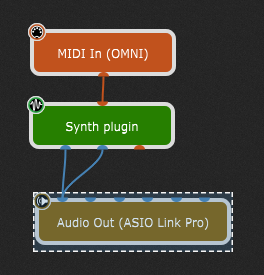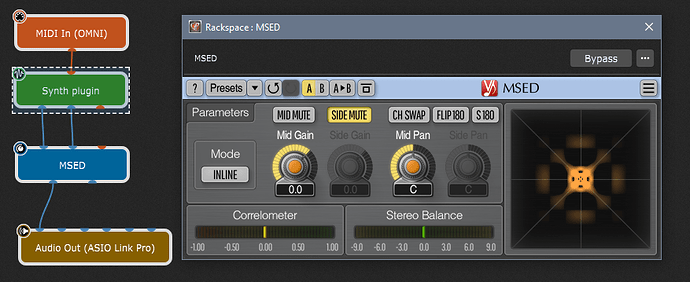I’m switching to Gig Performer for a musical theatre gig next month, and I my current plan is pictured below. Can anyone with more experience and knowledge verify whether this is OK? Could it be simplified? I’m worried that if I run a single TRS from the Scarlett 2i2 (2nd gen), somehow it will cut off instruments that are panned. Is this a legit concern?
Generally it’s not a very good idea to use something like a Y-cable to combine two signals! Those cables are used to split a signal from one source to two targets, and even then it’s probably not the best way to do this. In short: forget this kind of cable!
The cheapest way to go (and it’s a safe way too!) is to combine the L/R channels of the stereo signal within Gig Performer and then simply use only one output of your audio interface to go into the theatre’s mixer.
Theoretically you could just connect both audio pins (L/R) of a stereo sum with one audio pin of your audio interfaces outputs (this would be the digital version of your Y-cable, but there would be no hassle with electrical issues like impedance and all this stuff):

But to be on the absolute safe side, and if you are probably concerned about possible phasing issues, you might even use one of those free stereo-to-mono plugins… i.e. this one:
Just connect the plugin/audio sources from a stereo sum to this plugin and then just activate “Side Mute”, which will keep only the center component of the signal and make a perfect mono signal… this should do!
The wiring in GP would look like this:
Wow! That is such a hilariously simple solution, and it never crossed my mind. That’s awesome, thank you.
I fully agree with most of your advices, but I would like to better understand this last tip. I thought that the Mid signal is only the sum of L+R (Left and Right channel of a stereo signal), while the Side signal is the difference L-R. So, I thought that when you join, within GP, L and R into on single audio channel, you implicitely get then Mid signal. Did I miss something? ![]()
Oh, just wasn’t entirely sure if simply combining L&R in GP would probably lead to unwanted effects, like phase cancellations, so i thought using a dedicated plugin for this could have been the “safer” choice.
I am afraid that phase cancellation would remain with this plugin too.To tell the truth, I wouldn’t know what to do in case of phase cancellation. I think I would simply merge the stereo channels in one within GP and hope no phase cancellation happen ![]()
Just to be safe, I added the MSED. So far, it sounds OK.
Is there really only one XLR free for you? If there would be two, each mono, but can be panned left and right for stereo at FOH.
Last I checked, it was completely full, but there might be one open. I think a majority of the blocks are used by the drummer, who honestly needs to consolidate his sound banks with Gig Performer. It would definitely sound better stereo. I’ll send FOH an email to check. Historically, they’ve only used mono on their keyboards.
In the digital world connecting both outputs of the synth plugin to one output to make it mono is perfectly fine. Of course you could use MSED from Voxengo or MUtility from Melda Productions to do this for you, but it all boils down to the same thing: The value of sample of the left channel is added to the value of the sample of the right channel. No concern for phasing issues here.
In the physical world it is another thing: Connecting two physical outputs to one input might be a problem for the outputs (depending on the design). Most of the time the output stage is created with an op-amp that usually has a push-pull setup like these two (badly connected) output stages:

If two outputs are connected with no safe guards, and the input signal at the left side is positive and on the right side is negative (180 degrees of the left signal)), you end up with a short circuit between +Vcc and -Vcc (highlighted in yellow). In such a scenario, without counter measures, something gotta have to give…, probably one of the transistors, or the power supply just stops (hopefully gracefully). Op-amps might have some protections to cope with this kind of abuse, but I certainly would not try this with the main amplifiers of a PA.
Of course there is a simple solution (that about all mixers internally use): place a resistor in line with each output and use the signal that is available where the two resistors are connected. At that point the signal is the sum of the two outputs:

Gist of all this:
- For physical devices: Don’t connect two outputs to one input!
- For digital processing of outputs of vsts, input blocks, and so on within GP or DAWs it is perfectly safe to connect the outputs (no risk of burning up your floating point co-processor
 )
)
I hope this clarifies things.
Thank you so much for this accurate clarification! Good to know (and not just to guess)! ![]()
![]()
Agreed, this is super helpful. Thanks for the detailed clarification!
Late to the party as usual. There is one minor issue when mono summing digitally, and that comes from the VSTi/fx you are trying to use.
In particular, some stereo sampled instruments, like the Scarbee Clav, end up phasing when played in mono. I’ve had various pianos like Ivory do this, too. You might not notice anything on the synths unless you were applying a stereo widener which rotates or smears the phase. Obviously nothing sounds wider in mono, but the effect of the phase widener fx in mono is that the sounds can sometimes almost disappear.
Pianoteq is amazing for replicating mono piano and keys. You can quite literally select one mic, place it in your digital ‘room’, and set output to mono.
For a mono-summed FOH PA, which is a lot of smaller venues, the more you know your sounds beforehand, how they sound in mono, the better. Easy to replicate a mono system to hear it, too. Just practice with a single speaker. Seriously.

